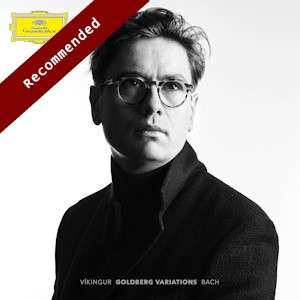
Johann Sebastian Bach (1685-1750)
Goldberg Variations, BWV988
Víkingur Ólafsson (piano)
rec. 2023, Norðurljós Hall, Harpa Concert House, Reykjavík, Iceland
Deutsche Grammophon 4864553 [74]
In the world of piano fancying, there cannot have been a more keenly anticipated release than this new set of the Goldberg Variations. Since he exploded onto the scene with 2018’s blistering Bach recital, Vikingur Ólafsson has teased us with albums devoted to Debussy, Rameau, Mozart and others but precious little Bach. Great though most of those discs were what most listeners were waiting for was the moment Vikingur – and remarkably even at this early stage in his career we are definitely on first name terms – would commit one of the big Bach works to record. And now here it is – and it has most decidedly been worth the wait.
Any new recording of the Goldbergs must run the gauntlet of whether there remains anything truly distinctive to be said about this much recorded work. With a pianist as distinctive as Vikingur Ólafsson there is little need to worry. His ultra ultra fine touch is one of the unmistakable sounds in piano playing and he plays this monumental work as if he has weighed the precise timbre and articulation of each and every note like it was a precious diamond. That he does so without any hint of artificiality is in itself one of the most remarkable features of his interpretation. To take one example from a cornucopia, his extraordinary staccato effect in the 15th variation makes his piano sound almost like a souped up clavichord – the instrument of its era to which composers turned to express their most inward thoughts and feelings. And so it is here.
Anyone who has encountered his earlier Bach recording will know that there is much more to his playing than touch – razor sharp intelligence and ferocious energy are two qualities that immediately leap out at the listener. Put them all together and what emerges is one of the most comprehensive of reworkings of this great masterpiece.
So far, so technical but Ólafsson’s performance is just as alive with emotion. In one interview he has described how his view of the work shifted from that of an awesome cathedral to that of an equally awe inspiring but living oak tree. Sometimes this organic quality is reflected in a naughty sense of play – he is very far from taking himself too seriously here – but also sometimes in deep and compassionate sorrow. Bach’s encyclopaedic genius contains worlds and that is what we get on this recording. There is even, astonishingly, sensuality in the way he strokes the keys and the ears of the listener’s ears – sexy Bach anyone? He did father a prodigious number of children!
One of the difficulties in playing this piece, one that exercised Glenn Gould virtually his entire life, is how to present the canons that festoon it in such a way that Bach’s ingenuity can be made audible rather than the preserve of those who can analyse the pages of the score. Ultimately the complexity of the music must elude the capabilities of the performer but time and again Ólafsson gets tantalisingly close. It is one thing to let us hear the internal workings of the polyphony. It is quite another to do so without losing the grace and verve of the music in the process. If I say I have never heard so much of the detail before, it is never at the expense of the overall listening experience. It helps that he can play the most complex, knuckle cracking passages as though he were playing a Grade One piece.
Architecturally – or should that be horticulturally – Ólafsson is more of a leisurely Perahia or Schiff than an endlessly pushing on Gould. If the first variation of all goes off like a rocket this gives a false impression of his overall view which takes it time and gives the listener plenty of space to digest the music properly. Like Perahia and Schiff, he realises the risk that the piece as a whole might get bogged down and he keeps a close eye on Bach’s pacing of the variations and the way succeeding variations build toward climaxes before relaxing.
It is interesting that in the first variation and the last three, Ólafsson plays with a rather wild freedom as if to announce, ‘I will probably play this differently the next time I play it’ thereby avoiding any risk of this recording becoming as fixed and dead as a butterfly pinned to a board. The rising excitement of those final three variations – which is surely Bach at his most flamboyant – is a most effective way of leading back to the reprise of the aria upon which the work is based. That return of the aria at the end is as inevitable as the return of a comet following a vast, distant, elliptical orbit.
In practically every conceivable dimension this is a winner – recording quality, the range of timbres at his disposal, the intellectual rigour of the polyphony, the tenderness and fun, the long range planning, the stupendous technical sorcery. Any thought that Vikingur Ólafsson has been overhyped vanishes in a puff of smoke. I’m not sure it is possible to overhype playing this good.
David McDade
Previous review: David Barker (October 2023)
Help us financially by purchasing from




















